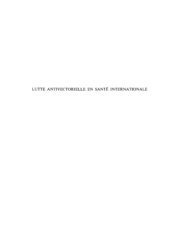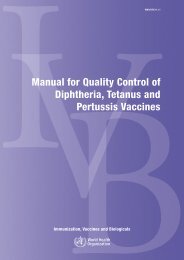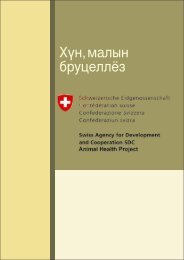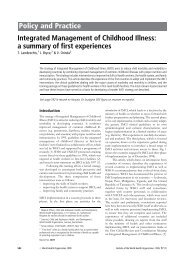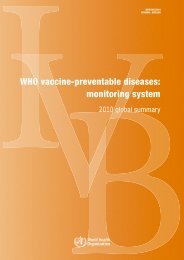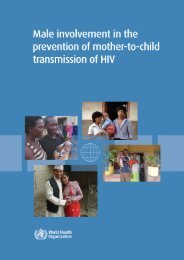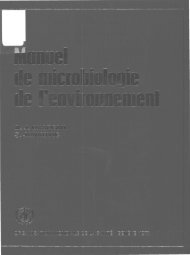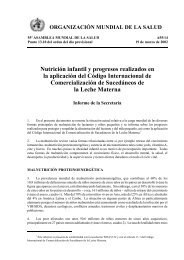Regulatory Situation of Herbal Medicines A worldwide Review
Regulatory Situation of Herbal Medicines A worldwide Review
Regulatory Situation of Herbal Medicines A worldwide Review
You also want an ePaper? Increase the reach of your titles
YUMPU automatically turns print PDFs into web optimized ePapers that Google loves.
WHO/TRM/98.1page 20Medicinal plants with or without obligation for registration (1 and 2) can be controlled by the health authority.For registration <strong>of</strong> medicinal plants (1), pharmacological and analytical documentation has to be presentedincluding indications, dosage, and the analytical methods. For plants which are not yet included in the list, it ispossible to apply for their inclusion [89].Preparations containing extracts, tinctures, distillates etc., and other galenical preparations, are regarded asmedicines which have to fulfil all the requirements <strong>of</strong> the Spanish Drug Law [90].SwedenThe Medicinal Products Act [91] also applies to natural remedies. In November 1994, the Medicinal ProductsAgency issued a guideline "Information on application for authorization to market natural remedies" [92]. Thisguideline contains detailed requirements and regulations for obtaining a marketing authorization for naturalremedies.According to the Medical Products Agency's Order and guidelines on marketing authorizations for medicinalproducts, a natural remedy is defined as follows:- A finished product intended for administration to human beings or animals for the prevention,diagnosis, relief or cure <strong>of</strong> diseases or symptoms <strong>of</strong> diseases.- A natural remedy denotes a medicine in which the active ingredient or ingredients derive from naturalsources such as plants or animals, or consist <strong>of</strong> a bacterial culture, mineral, salt or salt solution. Theactive ingredients however must not be processed too highly, e.g., constituents may not be chemicallymodified, produced by biotechnological methods or in a chemically defined isolated form.A natural remedy must be suitable and intended for self-medication in accordance with tested nationaltraditions or traditions <strong>of</strong> countries close to Sweden with respect to the drug use. Products for injection andhomoeopathic preparations are not covered by the definition [48,92].A marketing authorization is granted for five years by the Medical Products Agency and may be renewed. Thegeneral requirements for medicines <strong>of</strong> the <strong>Medicines</strong> Act <strong>of</strong> 1992 are also applicable to natural remedies. Theymust have a complete declaration <strong>of</strong> the contents, an acceptable name, and a clear label. Their manufacturehas to follow Good Manufacturing Practice (GMP).A simplified application procedure, according to Directive 65/65/EEC [30] which describes a bibliographicapplication, can usually be used. If the use <strong>of</strong> a preparation has become well established, full documentation<strong>of</strong> the results <strong>of</strong> pharmacological and toxicological investigations or clinical trials may be replaced by data frompublished scientific literature.The guideline contains detailed requirements for the application dossier and the fees. The documentationshould be in accordance with the European Notice to Applicants. The requirements for the documentation onquality take into consideration that natural remedies have special characteristics. For this reason, guidelinesfor the documentation on quality have been compiled as an annex to the main guideline.With respect to safety, consideration should be given primarily to the experience <strong>of</strong> corresponding earlier use<strong>of</strong> the product or constituents, in which no harmful effects have arisen or been suspected. If satisfactory pro<strong>of</strong><strong>of</strong> safety is not provided, then it should be established by means <strong>of</strong> clinical trials and/or pharmacological andtoxicological studies.As natural remedies are normally intended to treat diseases or conditions suitable for self-medication, theindications depend on the documentation which supports the application. For well documented ingredients forwhich there is adequate experience, reliable bibliographical data may be sufficient for the efficacyassessment. If the product has not been used traditionally, the application has to be supplemented with aspecific product-related documentation, and results <strong>of</strong> clinical trials and pharmacological studies presented.Combination products containing several active ingredients need a special explanatory statement in theapplication. A fundamental precondition for the approval <strong>of</strong> combination products is that each active ingredientcontributes to the overall effect. No restriction has been placed on the number <strong>of</strong> herbal drugs included in aremedy provided that the documentation is satisfactory with respect to quality, safety and efficacy.The guideline also contains information on the processing <strong>of</strong> applications, possibilities <strong>of</strong> modifications andnotifications there<strong>of</strong>, and detailed requirements for product information such as labelling and the package



